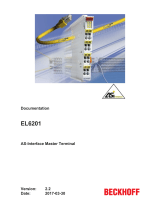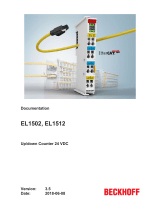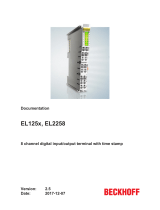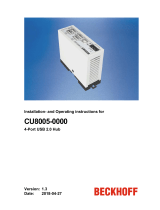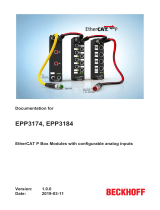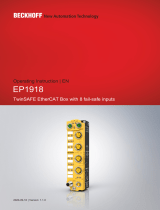Page is loading ...

Documentation
EJ7211-0010
Servomotor module for OCT, 48 V DC, 4.5 A (Irms)
1.0
2020-06-26
Version:
Date:


Table of contents
EJ7211-0010 3Version: 1.0
Table of contents
1 Foreword ....................................................................................................................................................5
1.1 Notes on the documentation..............................................................................................................5
1.2 Safety instructions .............................................................................................................................6
1.3 Intended use......................................................................................................................................7
1.4 Documentation issue status ..............................................................................................................7
1.5 Guide through documentation ...........................................................................................................7
1.6 Marking of EtherCAT plug-in modules...............................................................................................8
1.6.1 Beckhoff Identification Code (BIC)................................................................................... 10
1.6.2 Certificates....................................................................................................................... 12
2 System overview .....................................................................................................................................13
3 Product Overview ....................................................................................................................................14
3.1 EJ7211-0010 - Introduction .............................................................................................................14
3.2 EJ7211-0010 - Technical data.........................................................................................................15
3.3 Technology ......................................................................................................................................16
3.4 EJ7211-0010- Pinout.......................................................................................................................19
3.5 EJ7211-0010 - LEDs .......................................................................................................................20
4 Installation of EJ modules ......................................................................................................................21
4.1 Power supply for the EtherCAT plug-in modules.............................................................................21
4.2 EJxxxx - dimensions........................................................................................................................23
4.3 Installation positions and minimum distances .................................................................................24
4.3.1 Minimum distances for ensuring installability................................................................... 24
4.3.2 Installation positions ........................................................................................................ 25
4.4 Notes on current measurements using Hall sensors.......................................................................27
4.5 Codings ...........................................................................................................................................28
4.5.1 Color coding..................................................................................................................... 28
4.5.2 Mechanical position coding.............................................................................................. 29
4.6 Installation on the signal distribution board .....................................................................................30
4.7 Extension options ............................................................................................................................32
4.7.1 Using placeholder modules for unused slots ................................................................... 32
4.7.2 Linking with EtherCAT Terminals and EtherCAT Box modules via an Ethernet/EtherCAT
connection ....................................................................................................................... 33
4.8 IPC integration.................................................................................................................................34
4.9 Disassembly of the signal distribution board ...................................................................................36
5 EtherCAT basics......................................................................................................................................37
6 Commissionin..........................................................................................................................................38
6.1 Note to EL7211-0010 documentation..............................................................................................38
7 Diagnostics – basic principles of diag messages................................................................................39
8 Appendix ..................................................................................................................................................49
8.1 EtherCAT AL Status Codes.............................................................................................................49
8.2 EJ7211-0010 - Firmware compatibility ............................................................................................49
8.3 Firmware Update EL/ES/EM/ELM/EPxxxx ......................................................................................49
8.3.1 Device description ESI file/XML....................................................................................... 50
8.3.2 Firmware explanation ...................................................................................................... 53

Table of contents
EJ7211-00104 Version: 1.0
8.3.3 Updating controller firmware *.efw................................................................................... 54
8.3.4 FPGA firmware *.rbf......................................................................................................... 56
8.3.5 Simultaneous updating of several EtherCAT devices...................................................... 60
8.4 Restoring the delivery state .............................................................................................................61
8.5 Support and Service ........................................................................................................................62

Foreword
EJ7211-0010 5Version: 1.0
1 Foreword
1.1 Notes on the documentation
Intended audience
This description is only intended for the use of trained specialists in control and automation engineering who
are familiar with the applicable national standards.
It is essential that the documentation and the following notes and explanations are followed when installing
and commissioning these components.
It is the duty of the technical personnel to use the documentation published at the respective time of each
installation and commissioning.
The responsible staff must ensure that the application or use of the products described satisfy all the
requirements for safety, including all the relevant laws, regulations, guidelines and standards.
Disclaimer
The documentation has been prepared with care. The products described are, however, constantly under
development.
We reserve the right to revise and change the documentation at any time and without prior announcement.
No claims for the modification of products that have already been supplied may be made on the basis of the
data, diagrams and descriptions in this documentation.
Trademarks
Beckhoff
®
, TwinCAT
®
, EtherCAT
®
, EtherCATG
®
, EtherCATG10
®
, EtherCATP
®
, SafetyoverEtherCAT
®
,
TwinSAFE
®
, XFC
®
, XTS
®
and XPlanar
®
are registered trademarks of and licensed by Beckhoff Automation
GmbH. Other designations used in this publication may be trademarks whose use by third parties for their
own purposes could violate the rights of the owners.
Patent Pending
The EtherCAT Technology is covered, including but not limited to the following patent applications and
patents: EP1590927, EP1789857, EP1456722, EP2137893, DE102015105702 with corresponding
applications or registrations in various other countries.
EtherCAT
®
is registered trademark and patented technology, licensed by Beckhoff Automation GmbH,
Germany.
Copyright
© Beckhoff Automation GmbH & Co. KG, Germany.
The reproduction, distribution and utilization of this document as well as the communication of its contents to
others without express authorization are prohibited.
Offenders will be held liable for the payment of damages. All rights reserved in the event of the grant of a
patent, utility model or design.

Foreword
EJ7211-00106 Version: 1.0
1.2 Safety instructions
Safety regulations
Please note the following safety instructions and explanations!
Product-specific safety instructions can be found on following pages or in the areas mounting, wiring,
commissioning etc.
Exclusion of liability
All the components are supplied in particular hardware and software configurations appropriate for the
application. Modifications to hardware or software configurations other than those described in the
documentation are not permitted, and nullify the liability of Beckhoff Automation GmbH & Co. KG.
Personnel qualification
This description is only intended for trained specialists in control, automation and drive engineering who are
familiar with the applicable national standards.
Description of instructions
In this documentation the following instructions are used.
These instructions must be read carefully and followed without fail!
DANGER
Serious risk of injury!
Failure to follow this safety instruction directly endangers the life and health of persons.
WARNING
Risk of injury!
Failure to follow this safety instruction endangers the life and health of persons.
CAUTION
Personal injuries!
Failure to follow this safety instruction can lead to injuries to persons.
NOTE
Damage to environment/equipment or data loss
Failure to follow this instruction can lead to environmental damage, equipment damage or data loss.
Tip or pointer
This symbol indicates information that contributes to better understanding.

Foreword
EJ7211-0010 7Version: 1.0
1.3 Intended use
WARNING
Caution - Risk of injury!
EJ components may only be used for the purposes described below!
1.4 Documentation issue status
Version Comment
1.0 • First publication of EJ7211-0010
1.5 Guide through documentation
NOTE
Further components of documentation
The documentations named in the following table are further compontents of the complete
documentation. These documentations are required for the use of EtherCAT plug-in mod-
ules.
No. Title Description
[1]
EtherCAT System Documentation
• System overview
• EtherCAT basics
• Cable redundancy
• Hot Connect
• Distributed Clocks
• Configuration of EtherCAT-Components
[2]
Infrastructure for EtherCAT/Ethernet
• Technical recommendations and notes for
design, implementation an testing
[3]
Design GuideSignal-Distribution-Board for
standard EtherCAT plug-in modules
Requirements for the design of a Signal-
Distribution-Board for standard EtherCAT plug-in
modules
• Backplane mounting guidelines
• Module placement
• Routing guidelines
[4] Documentation of the corresponding terminal
ELxxxx
• Notes on the principle of operation and
• Descriptions for configuration and
parameterization
are transferable to the corresponding Module
EJxxxx (s. note on documentation of ELxxxx
[}38]).

Foreword
EJ7211-00108 Version: 1.0
1.6 Marking of EtherCAT plug-in modules
Designation
A Beckhoff EtherCAT device has a 14-digit technical designation, made up as follows (e.g.
EJ1008-0000-0017)
• Order identifier
◦ family key: EJ
◦ product designation: The first digit of product designation is used for assignment to a product
group (e.g. EJ2xxx = digital output module).
◦ Version number: The four digit version number identifies different product variants.
• Revision number:
It is incremented when changes are made to the product.
The Order identifier and the revision number are printed on the side of EtherCAT plug-in modules (s.
following illustration (A and B).
Fig.1: Order identifier (A), Revision number (B) and serial number (C) using the example of EJ1008
Product group Example
Product designation Version Revision
EtherCAT Coupler
EJ11xx
EJ1101 -0022
(Coupler with external connectors, power supply module and
optional ID switches
-0016
Digital input modules
EJ1xxx
EJ1008
8-channel
-0000
(basic type)
-0017
Digital output modules
EJ2xxx
EJ2521
1-channel
-0224
(2 x 24V outputs)
-0016
Analog input modules
EJ3xxx
EJ3318
8-channel thermocouple
-0000
(basic type)
-0017
Analog output modules
EJ4xxx
EJ4134
4-channel
-0000
(basic type)
-0019
Special function modules
EJ5xxx, EJ6xxx
EJ6224
IO-Link master
-0090
(with TwinSAFE SC)
-0016
Motion modules
EJ7xxx
EJ7211
servomotor
-9414
(with ECT, STO and TwinSAFE SC)
-0029

Foreword
EJ7211-0010 9Version: 1.0
Notes
• The elements mentioned above result in the technical designation. EJ1008-0000-0017 is used in the
example below.
• EJ1008-0000 is the order identifier, in the case of “-0000” usually abbreviated to EJ1008.
• The revision -0017 shows the technical progress, such as the extension of features with regard to the
EtherCAT communication, and is managed by Beckhoff.
In principle, a device with a higher revision can replace a device with a lower revision, unless specified
otherwise, e.g. in the documentation.
Associated and synonymous with each revision there is usually a description (ESI, EtherCAT Slave
Information) in the form of an XML file, which is available for download from the Beckhoff web site.
• The product designation, version and revision are read as decimal numbers, even if they are
technically saved in hexadecimal.
Serial number
The serial number for EtherCAT plug-in modules is usually the 8-digit number printed on the side of the
module (see following illustration C). The serial number indicates the configuration in delivery state and
therefore refers to a whole production batch, without distinguishing the individual modules of a batch.
Fig.2: Order identifier (A), revision number (B) and serial number (C) using the example of EJ1008
Serial number Example serial number: 08 15 08 16
KK - week of production (CW, calendar week) 08 - week of production: 08
YY - year of production 15 - year of production: 2015
FF - firmware version 08 -f irmware version: 08
HH - hardware version 16 - hardware version: 16

Foreword
EJ7211-001010 Version: 1.0
1.6.1 Beckhoff Identification Code (BIC)
The Beckhoff Identification Code (BIC) is increasingly being applied to Beckhoff products to uniquely identify
the product. The BIC is represented as a Data Matrix Code (DMC, code scheme ECC200), the content is
based on the ANSI standard MH10.8.2-2016.
Fig.3: BIC as data matrix code (DMC, code scheme ECC200)
The BIC will be introduced step by step across all product groups.
Depending on the product, it can be found in the following places:
• on the packaging unit
• directly on the product (if space suffices)
• on the packaging unit and the product
The BIC is machine-readable and contains information that can also be used by the customer for handling
and product management.
Each piece of information can be uniquely identified using the so-called data identifier (ANSI
MH10.8.2-2016). The data identifier is followed by a character string. Both together have a maximum length
according to the table below. If the information is shorter, it shall be replaced by spaces. The data under
positions 1-4 are always available.
The following information is contained:

Foreword
EJ7211-0010 11Version: 1.0
Item
no.
Type of informa-
tion
Explanation Data iden-
tifier
Number of digits
incl. data identifier
Example
1 Beckhoff order
number
Beckhoff order number 1P 8 1P072222
2 Beckhoff Traceability
Number (BTN)
Unique serial number,
see note below
S 12 SBTNk4p562d7
3 Article description Beckhoff article
description, e.g. EL1008
1K 32 1KEL1809
4 Quantity Quantity in packaging
unit, e.g. 1, 10, etc.
Q 6 Q1
5 Batch number Optional: Year and week
of production
2P 14 2P4015031800
16
6 ID/serial number Optional: Present-day
serial number system,
e.g. with safety products
51S 12 51S678294104
7 Variant number Optional: Product variant
number on the basis of
standard products
30P 32 30PF971 ,
2*K183
...
Further types of information and data identifiers are used by Beckhoff and serve internal processes.
Structure of the BIC
Example of composite information from items 1 - 4 and 6. The data identifiers are marked in red for better
display:
BTN
An important component of the BIC is the Beckhoff Traceability Number (BTN, item no. 2). The BTN is a
unique serial number consisting of eight characters that will replace all other serial number systems at
Beckhoff in the long term (e.g. batch designations on IO components, previous serial number range for
safety products, etc.). The BTN will also be introduced step by step, so it may happen that the BTN is not yet
coded in the BIC
Notice
This information has been carefully prepared. However, the procedure described is constantly being further
developed. We reserve the right to revise and change procedures and documentation at any time and
without prior notice. No claims for changes can be made from the information, illustrations and descriptions
in this information.

Foreword
EJ7211-001012 Version: 1.0
1.6.2 Certificates
• The EhterCAT plug-in modules meet the requirements of the EMC and Low Voltage Directive. The CE
mark is printed on the side of the modules.
• The cRUus imprint identifies devices that meet product safety requirements according to U.S. and
Canadian regulations.
• The warning symbol is a request to read the corresponding documentation. The documentations for
EtherCAT plug-in modules can be downloaded from the Beckhoff homepage.
Fig.4: Marking for CE and UL using EJ1008 as an example

System overview
EJ7211-0010 13Version: 1.0
2 System overview
Electronically, the EJxxxx EtherCAT plug-in modules are based on the EtherCAT I/O system. The EJ system
consists of the signal distribution board and EtherCAT plug-in modules. It is also possible to connect an IPC
to the EJ system.
The EJ system is suitable for mass production applications, applications with small footprint and applications
requiring a low total weight.
The machine complexity can be extended by means of the following:
• reserve slots,
• the use of placeholder modules,
• linking of EtherCAT Terminals and EtherCAT Boxes via an EtherCAT connection.
The following diagram illustrates an EJ system. The components shown are schematic, to illustrate the
functionality.
Fig.5: EJ system sample
Signal distribution board
The signal distribution board distributes the signals and the power supply to individual application-specific
plug connectors, in order to connect the controller to further machine modules. Using pre-assembled cable
harnesses avoids the need for time-consuming connection of individual wires. Coded components reduce
the unit costs and the risk of miswiring.
Beckhoff offers development of signal distribution boards as an engineering service. Customers have the
option to develop their own signal distribution board, based on the design guide.
EtherCAT plug-in modules
Similar to the EtherCAT terminal system, a module strand consists of a Bus Coupler and I/O modules.
Almost all of the EtherCAT Terminals can also be manufactured in the EJ design as EtherCAT plug-in
modules. The EJ modules are directly attached to the signal distribution board. The communication, signal
distribution and supply take place via the contact pins at the rear of the modules and the PCB tracks of the
signal distribution board. The coding pins at the rear serve as mechanical protection against incorrect
connection. Color coding on the housing facilitates distinguishing of the modules.

Product Overview
EJ7211-001014 Version: 1.0
3 Product Overview
3.1 EJ7211-0010 - Introduction
Fig.6: EJ7211-0010
Servomotor module with OCT, 48V
DC
, 4,5A (I
rms
)
The servomotor EtherCAT plug-in module EJ7211-0010 with integrated One Cable Technology (OCT) offers
high servo performance in a very compact design for the motor types of the AM8100 series, up to 4,5A (I
eff
).
The One Cable Technology combines a motor cable and an absolute feedback system in a single cable. The
integrated electronic type plate of the AM81xx motors can be read in automatically by the servo module to
configure the motor parameters automatically. Thus, wiring and commissioning expenditure are minimized.
The fast control technology, based on field-orientated current and PI speed control, supports fast and highly
dynamic positioning tasks. The monitoring of numerous parameters, such as overvoltage and undervoltage,
overcurrent, terminal temperature or motor load via the calculation of an I²T model, offer maximum
operational reliability. EtherCAT, as a high-performance system communication, and CAN-over-EtherCAT
(CoE), as the application layer, enable ideal interfacing with PC-based control technology. The latest power
semiconductors guarantee minimum power loss and enable feedback into the DC link when braking. The
LEDs indicate status, warning and error messages as well as possibly active limitations.
Recommended TwinCAT version
In order to be able to utilize the full power of module, we recommend using the module with Twin-
CAT 2.11 R3 or higher!
Mandatory hardware
The Module must be operated with a real-time capable computer and distributed clocks.
Approved motors
Trouble-free operation can only be guaranteed with motors approved by Beckhoff.

Product Overview
EJ7211-0010 15Version: 1.0
3.2 EJ7211-0010 - Technical data
Technical data EJ7211-0010
Number of outputs 1 x servomotor, absolute Feedback, motor brake, 2 digital inputls
Connection method Direct motor connection
Load type Permanent-magnet synchronous motors
DC link supply voltage 8...48V
DC
Output current I
N
4.5A (rms) / 6.3A
(peak value)
Peak current I
N
9A (rms) / 12.6A (peak value) for 1 second
Frequency range 0Hz..599Hz
PWM clock frequency 16kHz
Current controller frequency double PWM switching frequency
Rated speed controller frequency 16kHz
Output voltage motor brake 24V
DC
Max. motor holding brake output current max. 0.5A
Current consumption via E-bus typ. 130mA
Supports NoCoeStorage function yes
Electrical isolation 500 V (E-bus/signal voltage)
Permissible ambient temperature range during operation 0°C ... + 55°C
Permissible ambient temperature range during storage -25°C ... + 85°C
Permissible relative humidity 95%, no condensation
Operation altitude max. 2,000m
Dimensions (W x H x D) approx. 24mm x 66mm x 55mm
Weight approx. 50g
Mounting on single distribution board
Pollution degree 2
Installation position
Standard [}25]
Position of coding pins [}29]
1 and 8
Color coding orange
Vibration/shock resistance according to EN 60068-2-6 / EN 60068-2-27 (with corresponding sig-
nal distribution board)
EMC immunity/emission conforms to EN 61000-6-2 / EN 61000-6-4 (with corresponding sig-
nal distribution board)
EMC category Category C3 - standard
Category C2, C1 - auxiliary filter required
Protection class EJ module: IP20
EJ system: dependent on the signal distribution board and housing
Approval CE, UL
CE approval
The CE Marking refers to the EtherCAT plug-in module mentioned above.
If the EtherCAT plug-in module is used in the production of a ready-to-use end product (PCB in con-
junction with a housing), the manufacturer of the end product must check compliance of the overall
system with relevant directives and CE certification.
To operate the EtherCAT plug-in modules, they must be installed in a housing.

Product Overview
EJ7211-001016 Version: 1.0
3.3 Technology
The very compact EL72x1-xxxx servomotor module integrates a complete servo drive for servomotors up to
276W.
Servomotor
The servomotor is an electrical motor. Together with a servo amplifier the servomotor forms a servo drive.
The servomotor is operated in a closed control loop with position, torque or speed control.
The servo module EJ72x1-xxxx supports control of permanent magnet synchronous motors. These consist
of three coils which are offset by 120° and a permanent magnet rotor.
Fig.7: Three synchronous motor coils, each offset by 120°
Servomotors particularly demonstrate their advantages in highly dynamic and precise positioning
applications:
• very high positioning accuracy in applications where maximum precision is required through integrated
position feedback
• high efficiency and high acceleration capacity
• servomotors are overload-proof and therefore have far greater dynamics than stepper motors, for
example.
• load-independent high torque right up to the higher speed ranges
• maintenance requirements reduced to a minimum
The EtherCAT servomotor module offers users the option to configure compact and cost-effective systems
without having to give up the benefits of a servomotor.
The Beckhoff servo module
The EJ72x1-xxxx is a fully capable servo drive for direct connection to servomotors in the lower performance
range. There is no need for further modules or cabling to make a connection to the control system. This
results in a very compact control system solution. The E-Bus connection of the EJ72x1-xxxx makes the full
functionality of EtherCAT available to the user. This includes in particular the short cycle time, low jitter,
simultaneity and easy diagnostics provided by EtherCAT. With this performance from EtherCAT the
dynamics that a servomotor can achieve can be used optimally.

Product Overview
EJ7211-0010 17Version: 1.0
A rated voltage of max. 48V
DC
and a rated current of max. 4.5A enable the user to drive a servomotor with a
rating of up to 276W. Permanent magnet synchronous motors with a rated current of up to 4.5A can be
connected as loads. The monitoring of numerous parameters, such as overvoltage and undervoltage,
overcurrent, module temperature or motor load, offers maximum operational reliability. Modern power
semiconductors guarantee minimum power loss and enable feedback into the DC link when braking.
The integrated fast control technology, with a field-orientated current and PI speed control, supports highly
dynamic positioning tasks. Apart from the direct connection of motor and resolver, the connection of a motor
holding brake is also possible.
The EJ72x1-xx1x EtherCAT plug-in module has two digital inputs that can be used for the “Touch Probe”
function. The status of the inputs can be read by “Select Info Data” (MDP742 profile and DS402 profile).
Connection to the control system
A further big advantage of the EJ72x1-xxxx is the easy incorporation into the control solution. The complete
integration into the control system simplifies commissioning and parameterization. As with all the other
EtherCAT plug-in modules, the EJ72x1-xxxx is simply plugged onto the signal distribution board. Then the
full module network can be scanned by the TwinCAT System Manager or manually added by the application
engineer. In the System Manager the EJ72x1-xxxx can be linked with the TwinCAT NC and parameterized.
Scalable motion solution
The servo module complements the product range of compact drive technology for Beckhoff I/O systems
that are available for stepper motors, AC and DC motors. With the EJ72x1-xxxx servo module, the range of
servo drives becomes even more finely scalable: from the miniature servo drive up to 170W in the EtherCAT
plug-in module through to the AX5000 servo drive with 118kW, Beckhoff offers a wide range including the
servomotors.
The AM31xx series was specially developed for the servomotor terminal EL72x1 / the servomotor module
EJ72x1.
One Cable Technology (OCT)
In the servomotors from the AM8100-xF2 x series the feedback signals are transmitted directly via the power
supply cable, so that power and feedback system are combined in a single motor connection cable. With the
use of the One Cable technology, the information is sent reliably and without interference through a digital
interface. Since a cable and plug are omitted at both the motor and controller end, the component and
commissioning costs are reduced.
Thermal I²T motor model
The thermal I²T motor model represents the thermal behavior of the motor winding taking into account the
absolute thermal resistance R
th
and the thermal capacity C
th
of motor and the stator winding.
The model assumes that the motor reaches its maximum continuous operating temperature T
nom
during
continuous operation with rated current I
nom
. This temperature corresponds to 100% motor load. During
operation at rated current the motor model reaches a load of 63% after a time of τ
th
=R
th
∙C
th
and slowly
reaches its continuous operating temperature.
If the motor is operated with a current that is greater than the rated current, the model reaches 100% load
more quickly.
If the load of the I²T model exceeds 100%, the requested set current is limited to the rated current, in order to
protect the motor winding thermally. The load reduces to a maximum of 100%. If the current falls below the
rated current, the load falls below 100% and the set current limitation is cancelled.
For a motor that has been cooled to ambient temperature, the time for reaching 100% load with a set current
that exceeds the rated current can be estimated with τ
th
∙I
nom
²/I
actual
².
The actual load must be known for exact calculation of the time when the 100% load threshold is exceeded.

Product Overview
EJ7211-001018 Version: 1.0
Fig.8: Limitation to the rated motor current

Product Overview
EJ7211-0010 19Version: 1.0
3.4 EJ7211-0010- Pinout
Fig.9: EJ7211-0010 - Pinout
The PCB footprint can be downloaded from the Beckhoff homepage.
NOTE
Damage to devices possible!
• The pins named with “NC” must not be connected.
• Before installation and commissioning read the chapters Installation of EJ modules
[}21] and Commissioning!

Product Overview
EJ7211-001020 Version: 1.0
3.5 EJ7211-0010 - LEDs
Fig.10: EJ7211-0010 - LEDs
LEDs (left prism)
LED Color Display State Meaning
RUN green off Init State of the EtherCAT State Machine: INIT = Initialization of the terminal or BOOT-
STRAP = Function for firmware updates of the terminal
blinking Pre-Opera-
tional
State of the EtherCAT State Machine: PREOP = Setting for mailbox communication
and variant standard settings
single
flash
Safe-Opera-
tional
State of the EtherCAT State Machine: SAFEOP = Channel checking of the Sync Man-
ager and the Distributed Clocks. Outputs stay in safe operation mode.
on Operational State of the EtherCAT State Machine: OP = Normal operation mode, mailbox- and
process data communication possible
flimmernd Bootstrap
State of the EtherCAT State Machine: BOOTSTRAP = function for firmware updates
[}49] of the plug-in module.
Read OCT green blinking - The electronic type plate is read
off - Reading of the electronic type plate was finished
I1..I2 green off - Signal voltage “0”
on - Signal voltage “1”
LEDs (right prism)
LED Color Display Meaning
Driver green on Driver stage ready for operation
+48V green off The power supply voltage (48V
DC
) is absent
on The power supply voltage (48V
DC
) is present
Up green off No power supply 24V
DC
is connected
on Power supply 24V
DC
is connected
Enable green on The LED is linked with bits 1 and 2 of the Status word (MDP742 / DS402) (if “Switched on” or “Oper-
ation enabled”)
The driver stage is enabled
LIMIT yellow on The LED is linked with bit 11 of the Status word (MDP742 / DS402) (Internal limit active)
Limit is reached (e.g. torque or speed limit)
WARN yellow blinking Error while reading the electronic identification plate.
on The LED is linked with bit 7 of the Status word (MDP742 / DS402) (Warning)
•The “Warning” threshold value is exceeded.
•I²T model
•80°C temperature exceeded
•Voltage
ERR red on The LED is linked with bit 3 of the Status word (MDP742 / DS402) (Fault)
•The “Error” threshold value is exceeded
•Overcurrent
•Voltage not available
•Resolver not connected
•Max. temperature (100°C) exceeded
/
